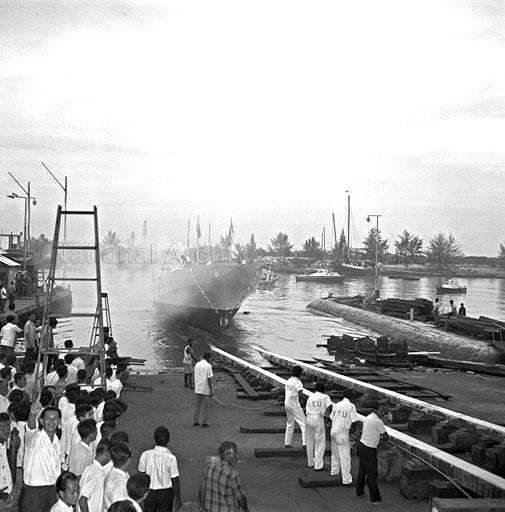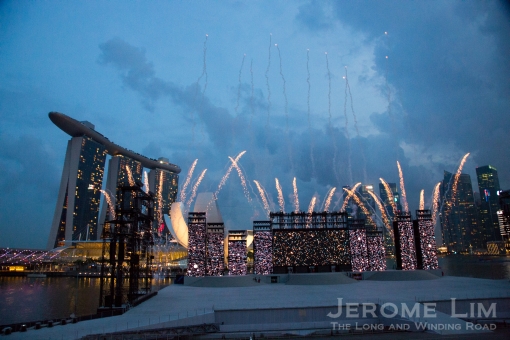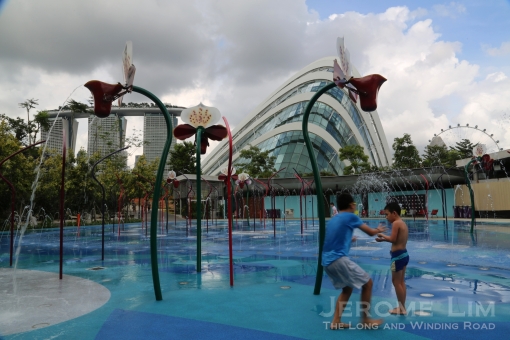The sea of light that descends once every two years on Marina Bay, i Light Marina Bay, is back for a fourth time.
The 2016 edition of i Light Marina Bay, following which the festival will make its return on an annual basis, runs from 4 to 27 March. With 14 out of its 25 installations created locally along the lines of the festival theme ‘In Praise of Shadows’, this edition sees the largest turn out of local artists to date.
As with previous years, the festival invites visitors to take a walk of discovery around the futuristic Marina Bay area around which the installations are scattered. There will also be much to do beyond admiring the artwork with lots of fringe events and activities on offer, including the opportunity to indulge in one of Singapore’s favourite pastimes, eating.
Fringe events to look out for include a craft beer festival, CRAFT Singapore and the Singapore International Jazz Festival – both of which run from 4 to 6 March, PasarBella Goes to Town from 11 March to 3 April, flea markets, activities for kids including a kids fiesta and fairground rides with Uncle Ringo. Workshops and community activities will also be held during the period. More information on all of this can be found on the festival guide which can be downloaded at http://www.ilightmarinabay.sg/-/media/Files/i-Light/Festival-Guide.ashx and also at http://www.ilightmarinabay.sg/Discover/Festival. More information on the festival and installations can also be found at the i Light Marina Bay event website.
Some i Light Highlights
What a Loving, and Beautiful World by team-Lab (Japan)

‘What a Loving, and Beautiful World’ – a projection on the ArtScience Museum, which invites viewers to ‘swipe’ Chinese characters onto the museum’s facade using their mobile devices through a web application found at http://www.ilight.team-lab.com.
About the installation:
First carved in tortoiseshell, ox and deer bone, and bronzeware, Chinese characters were said to each contain their own world. Projected on the facade of the ArtScience Museum, viewers can participate by ‘swiping’ the Chinese characters onto the facade of the building using a web application. The result is a colourful, multi-sensory experience that continuously evolves as images are released from these Chinese characters, while influencing and changing each other within its own immersive, computer-generated world.
More at : http://www.ilightmarinabay.sg/Discover/Installations/What-a-Loving-Beautiful-World
Lampshade by Snøhetta (Norway)

About the installation:
Lampshade is made of simple bamboo structures covered in photovoltaic cells to prevent sunlight from entering its interior in the day, while lighting up intensively at night with solar energy enough to power a thousand lamps. The installation challenges the perception of artificial light as an element that is dependent on its energy source, and invites visitors to discover links in harnessing sunlight and the eventual electric light.
Made to be both socially and environmentally friendly, the lamps used in this installation will be donated to off-grid communities after its display while the bamboo structure and its light fixtures will be recycled as construction scaffolding.
More at : http://www.ilightmarinabay.sg/Discover/Installations/Lampshade
Moon Haze by Feng Jiacheng & Huang Yuanbei (China)

About the installation:
Beyond its delightful representation of the full moon, Moon Haze also functions as a monitoring system for air pollutants, picking up and responding to the ambient air quality – the better the air quality, the brighter the installation. In the same space occupied by the moon, people and the environment, the collective effects of these individual parts on one another are integrated and expressed, showing their close relationship and inseparability.
More at : http://www.ilightmarinabay.sg/Discover/Installations/Moon-Haze
Shadow Bath by Loop.pH (United Kingdom)

About the installation:
Shadow Bath is a luminous inflated bathhouse with coloured light and air casting spectacular patterns inside and out, bathing visitors in dynamic patterned shades. The pneumatic form is a mathematical toroidal space, signifying the geometry of the universe.
During certain periods, visitors will be able to enter the bathhouse for a unique light show. During normal times, visitors can observe the form from the outside as it casts its patterned moiré shadows far and wide like a huge lantern.
More at : http://www.ilightmarinabay.sg/Discover/Installations/Shadow-Bath
Cycle House by Hafiz Osman (Singapore)

About the installation:
Cycle House is a mobile workstation combining temporary shelter and cycling. The mobility of this shelter represents a sense of nomadic livelihood of a wanderer, being adaptive to new environments and with a desire to search for new adventures. Two cycle houses have been created: the stationary house invites visitors to cycle to light up the piece while expressing their ideas of exploration by drawing on the canvas wall; the mobile house brings a more energetic, disco-themed performance to the bay.
About the More at : http://www.ilightmarinabay.sg/Discover/Installations/Cycle-House
TORRENT by Brandon Tay (Singapore)

About the installation:
TORRENT is a site-specific interactive installation that aims to transport users into a dreamlike landscape. As users walk past the screen, they find their movements reflected on a screen against an icy landscape, as if a virtual shadow with a swarm of trailing particles, with their motions mirrored but their forms vague.
More at : http://www.ilightmarinabay.sg/Discover/Installations/Torrent
Bolt by Jun Ong (Malaysia)

About the installation:
Inspired by the form and behaviour of lightning, the installation comprises an intricate network of LED tubes resting on steel legs that flare up when touched. Bolt not only mimics the ethereal nature of lightning, but also allows people to experience direct visceral connections, creating an emotional ‘spark’ that seems to be diminishing in today’s virtually-connected world.
More at : http://www.ilightmarinabay.sg/Discover/Installations/Bolt
Angels of Freedom by OGE Group, Gaston Zahr & Merav Eitan (Germany & Israel )

About the installation:
Five sets of giant, colourful wings invite visitors to come close and interact with the symbolic angels. This installation seeks to remind visitors of their true selves and to always remain connected to loved ones and those who matter.
More at : http://www.ilightmarinabay.sg/Discover/Installations/Angels-of-Freedom
Lightscape Pavilion by MisoSoupDesign (Taiwan)

About the installation:
Inspired by traditional Chinese lanterns, Lightscape Pavilion is made of simple, natural materials. Its bamboo lattice is designed to resemble a traditional lantern and its responsive glow serves to unite people under its canopy. The transparency and subtlety of the pavilion places emphasis and focus on the aesthetical beauty of its surroundings and inhabitants instead of its own self. As visitors move closer to its columns, its glow intensifies, as if to symbolically draw strength from the proximity of a human spirit.
More at : http://www.ilightmarinabay.sg/Discover/Installations/Lightscape-Pavilion
Groove Light by Department of Architecture, School of Design and Environment, National University of Singapore (Singapore)

About the installation:
Groove Light generates geometric shadow patterns when a point light source is shone through five 3D printed lanterns, creating a carpet of light giving physical dimension – in the complex forms of the lanterns – to virtual projections. The suspended lanterns are positioned with precision to create a continuous lightscape which visitors can modify by moving the lanterns.
More at : http://www.ilightmarinabay.sg/Discover/Installations/Groove-Light
Some other things to look out for:
Pop-up Royal Tea Salon by Häagen-Dazs at the Promontory



Must try at the Royal Tea Salon are Häagen-Dazs’ Spring collection of flavours including the Royal Milk Tea – a blend of fresh and sweet Darjeeling tea and strong, malty and honey-like Assam tea.
KamPONG

An initiative by Innoverde that invites passersby to have a game of of ping pong on locally designed and custom fabricated tables. KamPONG is located at Mist Walk, close to where the Uncle Ringo rides are located. More information on KamPONG can be found at http://innoverde.com.sg/kampong/.



























































































































































































































































